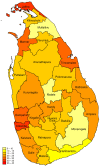Prevalence of diabetes and pre-diabetes in Sri Lanka: a new global hotspot-estimates from the Sri Lanka Health and Ageing Survey 2018/2019
- PMID: 36796852
- PMCID: PMC9936281
- DOI: 10.1136/bmjdrc-2022-003160
Prevalence of diabetes and pre-diabetes in Sri Lanka: a new global hotspot-estimates from the Sri Lanka Health and Ageing Survey 2018/2019
Abstract
Introduction: This study's objective was to produce robust, comparable estimates of the prevalence of diabetes and pre-diabetes in the Sri Lankan adult population, where previous studies suggest the highest prevalence in South Asia.
Research design and methods: We used data on 6661 adults from the nationally representative 2018/2019 first wave of the Sri Lanka Health and Ageing Study (SLHAS). We classified glycemic status based on previous diabetes diagnosis, and either fasting plasma glucose (FPG), or FPG and 2-hour plasma glucose (2-h PG). We estimated crude and age-standardized prevalence of pre-diabetes and diabetes and by major individual characteristics weighting the data to account for study design and subject participation.
Results: Crude prevalence of diabetes in adults was 23.0% (95% CI 21.2% to 24.7%) using both 2-h PG and FPG, and age-standardized prevalence was 21.8% (95% CI 20.1% to 23.5%). Using only FPG, prevalence was 18.5% (95% CI 7.1% to 19.8%). Previously diagnosed prevalence was 14.3% (95% CI 13.1% to 15.5%) of all adults. The prevalence of pre-diabetes was 30.5% (95% CI 28.2% to 32.7%). Diabetes prevalence increased with age until ages ≥70 years and was more prevalent in female, urban, more affluent, and Muslim adults. Diabetes and pre-diabetes prevalence increased with body mass index (BMI) but was as high as 21% and 29%, respectively, in those of normal weight.
Conclusions: Study limitations included using only a single visit to assess diabetes, relying on self-reported fasting times, and unavailability of glycated hemoglobin for most participants. Our results indicate that Sri Lanka has a very high diabetes prevalence, significantly higher than previous estimates of 8%-15% and higher than current global estimates for any other Asian country. Our results have implications for other populations of South Asian origin, and the high prevalence of diabetes and dysglycemia at normal body weight indicates the need for further research to understand the underlying drivers.
Keywords: diabetes mellitus, type 2; epidemiology; longitudinal studies.
© Author(s) (or their employer(s)) 2023. Re-use permitted under CC BY-NC. No commercial re-use. See rights and permissions. Published by BMJ.
Conflict of interest statement
Competing interests: None declared.
Figures


Similar articles
-
Prevalence and projections of diabetes and pre-diabetes in adults in Sri Lanka--Sri Lanka Diabetes, Cardiovascular Study (SLDCS).Diabet Med. 2008 Sep;25(9):1062-9. doi: 10.1111/j.1464-5491.2008.02523.x. Diabet Med. 2008. PMID: 19183311
-
Plasma glucose in screening for diabetes and pre-diabetes: how much is too much? Analysis of fasting plasma glucose and oral glucose tolerance test in Sri Lankans.BMC Endocr Disord. 2019 Jan 22;19(1):11. doi: 10.1186/s12902-019-0343-x. BMC Endocr Disord. 2019. PMID: 30670002 Free PMC article.
-
Regional Variation in Comorbid Prediabetes and Diabetes and Associated Factors among Hypertensive Individuals in Rural Bangladesh, Pakistan, and Sri Lanka.J Obes. 2019 Apr 30;2019:4914158. doi: 10.1155/2019/4914158. eCollection 2019. J Obes. 2019. PMID: 31183214 Free PMC article.
-
Prevalence of type 2 diabetes and pre-diabetes in Sri Lanka: a systematic review and meta-analysis.BMJ Open. 2023 Aug 28;13(8):e068445. doi: 10.1136/bmjopen-2022-068445. BMJ Open. 2023. PMID: 37640460 Free PMC article.
-
Plants used to treat diabetes in Sri Lankan Siddha Medicine - An ethnopharmacological review of historical and modern sources.J Ethnopharmacol. 2017 Feb 23;198:531-599. doi: 10.1016/j.jep.2016.07.053. Epub 2016 Jul 19. J Ethnopharmacol. 2017. PMID: 27448453 Review.
Cited by
-
Morbidity profile and pharmaceutical management of adult outpatients between primary and tertiary care levels in Sri Lanka: a dual-centre, comparative study.BMC Prim Care. 2024 Jun 6;25(1):200. doi: 10.1186/s12875-024-02448-8. BMC Prim Care. 2024. PMID: 38844839 Free PMC article.
-
The Prevalence and Epidemiological Features of Ischaemic Heart Disease in Sri Lanka.Glob Heart. 2024 Jun 3;19(1):49. doi: 10.5334/gh.1330. eCollection 2024. Glob Heart. 2024. PMID: 38854432 Free PMC article.
-
Prevalence and regional disparities of undiagnosed diabetes mellitus in Bangladesh: Results from the Bangladesh Demographic and Health Survey data.PLoS One. 2025 Apr 2;20(4):e0321069. doi: 10.1371/journal.pone.0321069. eCollection 2025. PLoS One. 2025. PMID: 40173172 Free PMC article.
-
Impact of Socio-Demographics and Knowledge, Attitudes, and Practices (KAP) on Misconceptions of Metformin Use in Diabetes: A Potential Myth and Disbelief in South Asia.Cureus. 2024 Aug 22;16(8):e67509. doi: 10.7759/cureus.67509. eCollection 2024 Aug. Cureus. 2024. PMID: 39310418 Free PMC article.
-
Scleredema Diabeticorum: A Rare Metabolic Connective Tissue Manifestation of Type 2 Diabetes Mellitus Causing External Restrictive Lung Disease.Cureus. 2024 May 15;16(5):e60374. doi: 10.7759/cureus.60374. eCollection 2024 May. Cureus. 2024. PMID: 38882981 Free PMC article.
References
-
- International Diabetes Federation . IDF diabetes atlas. 2021.
-
- Institute for Public Health. National Health and Morbidity Survey (NHMS) . 2019: non-communicable diseases, healthcare demand, and health literacy—key findings. Shah Alam, Selangor: Institute for Public Health, National Institutes of Health (NIH), Ministry of Health Malaysia, 2020.
Publication types
MeSH terms
Substances
LinkOut - more resources
Full Text Sources
Medical
